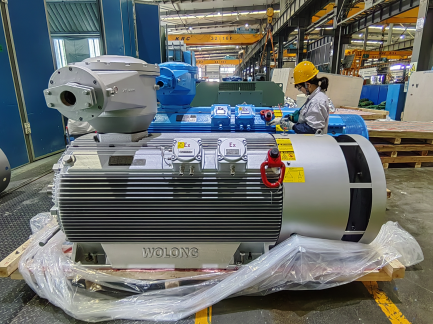High-voltage motor
It is generally believed that the motor with a supply voltage of 3KV~10KV is called a high-voltage motor. 6300V and 10000V motors are commonly used. Motor power is proportional to the product of voltage and current, so the power of the low-voltage motor increases to a certain extent (such as 300KW/380V), the rated current will be very large, the line loss will be squared with the current increase (I^2*r), the cross-sectional area of the wire is required to be very large, so the allowable bearing capacity of the cable is limited, and the cost is too high. At this time, it is necessary to increase the rated operating voltage to achieve high power output.
Low-voltage motor
Low voltage motor refers to the AC voltage below 1000V motor, generally refers to the AC 380V motor, 440V or 660V and other levels of asynchronous motors are actually used less. Low voltage motor is divided into AC asynchronous motor and DC motor two kinds.
Advantages and disadvantages of high-voltage motors compared with low-voltage motors
(1) Advantages
(1) can be made to a large power, up to thousands or even tens of thousands of kilowatts. This is because, in the same output power, high-voltage motor current can be much smaller than the low-voltage motor (basically inversely proportional to the voltage), for example, 500kW, 4-pole motor rated current, the rated voltage of 380V for 900A or so, while the rated voltage of 10kV only 30A or so. So the high voltage motor winding can be smaller wire diameter. As a result, the stator copper loss of a high-voltage motor will also be less than that of a low-voltage motor. For larger power motors, the use of low-voltage electricity, but because of the need for thicker wires and need a large area of the stator groove, so that the stator core diameter to do a lot of work, the entire size of the motor will also be very large.
② For larger capacity motors, high-voltage motors used in the power supply and distribution equipment than the overall investment in low-voltage motors less, and line loss is small, can save a certain amount of power consumption. In particular, 10kV high-voltage motors, you can directly use the network power supply (China’s high-voltage electricity provided to users are generally 10kV), so that the investment in power equipment (mainly transformers) will be less, the use of simpler, the failure rate will be less.

(2) Disadvantages
① The cost of the winding is relatively high (mainly caused by the insulation), and the cost of the related insulation materials will also be higher.
(ii) The insulation treatment process is more difficult, and the labor cost is higher.
③ The requirements for the use of the environment are much stricter than those for low-voltage motors.
Comparison of the difference between low voltage motor and high voltage motor
The main difference in structure
First, the coil insulation materials make a difference, low-voltage motors, coil mainly enameled wire or other simple insulation, such as composite paper, high-voltage motor insulation is usually used in multi-layer structure, such as powdered mica tape, the structure is more complex, higher degree of pressure resistance.
Second, the difference in cooling structure, low-voltage motors mainly use coaxial fans blowing directly to dissipate heat, high-voltage motors with most of the independent radiator, usually two kinds of fans, a set of internal circulation fan, a set of external circulation fan, two sets of fans running at the same time, heat exchange on the radiator will be discharged outside the motor heat.
Third, the bearing structure is different, low-voltage motors usually have a set of bearings before and after, while high-voltage motors, because of the heavy load, usually there are two sets of bearings at the axial end, and the number of bearings at the non-axial end is determined according to the load situation, and especially large motors will use sliding bearings.
Comparison of motor operation and cost
1. The higher the voltage level, the larger the motor capacity.
2, the higher the voltage level, the higher the installation cost; although the voltage increases the current becomes smaller, wire and cable cross-section can be selected smaller, but the need for high-voltage circuit breakers, transformers, switchgear and other equipment costs are still increased in the initial investment in the large, so small businesses in the new construction is willing to use low-voltage equipment.
3, the higher the voltage level, the lower the total operating costs; small current to bring about a reduction in power losses, in the long run is appropriate, the cumulative effect of power savings amazing, so many large enterprises in the technological transformation of low-voltage motors transformed into high-voltage motors.
4, the higher the voltage level, the more space occupied; because there are high-voltage control cabinets and other occupants.
5, the higher the voltage level, the motor is relatively easy to start, starting torque increase, start, control is relatively simple.
6, the higher the voltage level, the more complex maintenance management; so small businesses are willing to use low voltage, large enterprises are willing to use high-voltage motors.
Post time: Jun-12-2024

